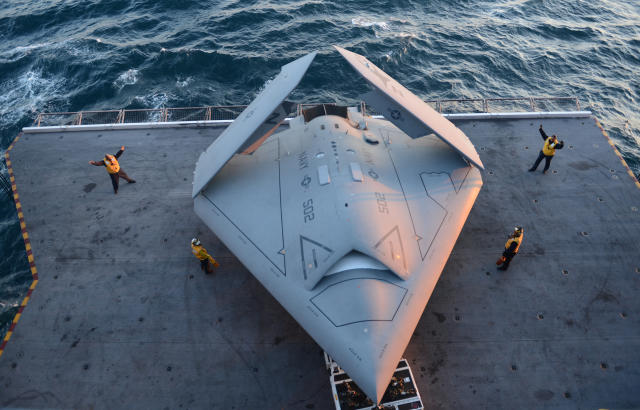CNO: New Stingray drone will be a tanker
Amid mounting criticism that the Navy’s new drone is suffering an identity crisis, the Navy’s top officer wants to make it clear: The MQ-25 Stingray is going to be tanker.
Critics argue that the next-generation unmanned aircraft was trying to do too much in aiming to be a tanker for the manned air wing and an roving sensor, but Chief of Naval Operations Adm. John Richardson emphasized in an interview that the yet-to-be-designed Stingray would be primarily for aerial refueling missions.
“The Navy is very clearly aligned on an unmanned aircraft that will provide, first and foremost, tanking to the air wing,” Richardson said in an Navy Times interview Monday. “We feel the need to extend the strike range of the air wing out and this will primarily be a mission tanker to extend that range out. Those are the features that will drive the design of the airframe.”
Richardson said that once the service gets the design for the aerial tanker straightened out, they can add intelligence, surveillance and reconnaissance features.
“Now when you get to that point, and you find the optimal things for the tanking mission, for little to no additional cost you can put a sensing payload on it and get some ISR benefit as a secondary feature of the aircraft,” Richardson said. “That is what we are building.”
The Stingray is slated to be the Navy's carrier-based UAV, following in the flight path of the X-47B that proved a drone could take off and land on flattops and refuel with piloted tankers. The plan for the Stingray came under fire recently after comments from the service’s top aviator were seen to mean the service was struggling with requirements.
During a presentation at the Center for Strategic and International Studies, Naval Air Forces head Vice Adm. Mike Shoemaker told the audience that designers were trying to find a balance between the design requirements for tanking — which requires a big fuel capacity to fly long distances — and the fuel efficient, big wingspan requirements for an ISR drone that can hover overhead for extended periods.
“If you’re going to be a tanker at range, you’re obviously going to have to be able to carry a fair amount of fuel internal to the platform. That drives the different design for those two,” Shoemaker said. "So the industry is working on an analysis of where that sweet spot is to do both of those missions.”
The Navy canceled a program to develop an unmanned ISR and strike platform in February in favor of an aerial tanker to increase the range of the aircraft carrier’s strike arm, as potential foes like China and Russia have been feverishly working to extend the range of their shore-based anti-ship missiles.
There should be no design trade-off that splits the difference between ISR and aerial tanking requirements, argues Jerry Hendrix, a retired naval flight officer and analyst with the Center for a New American Security.
“Shoemaker, to his credit, acknowledged that the design priorities of strike and ISR were discordant with each other,” Hendrix wrote in a column for National Defense Magazine. “It is clear that trying to get to a ‘sweet spot’ between these two is counterproductive and misses the point; the decision to cancel the Unmanned Carrier Launched Airborne Surveillance and Strike program and create the MQ-25 Stingray tanker was done specifically to speedily address the Navy’s strategic deficit in long range strike.”
In the interview, Richardson said the Navy is pushing to get the Stingray to the flattop fleet as fast as possible to start learning how to operate with unmanned aircraft. As the Navy adapts, Richardson said, the Stingray may evolve as well. But Richardson is also wary of creating a runaway program with ballooning requirements.
“As we get this on deck, we’re going to learn a tremendous amount on how to integrate an unmanned aircraft into an air wing: How to bring it on, take it off, maintain it at sea, and all those unique things that go along with that aircraft. All of that may allow us, as technology moves forward, to evolve.
“But for the first step it’s important that we confine our thinking so we can get something on the aircraft carrier quickly, as quickly as we can possibly move in fact, that will fulfill a legitimate need. We’ve got [F/A-18E/F] Super Hornets right now doing the tanking mission, I’d love to have those available for strike.”
In his remarks, Shoemaker stressed that tanking was the primary role of the aircraft, but that it was not going to be a stealth aircraft: something that was a key consideration of the UCLASS program. But preventing the taker from getting shot down is an important consideration to achieve the goal of extending the range of the air wing.
"I think in the latest round we have not stressed the survivability piece," Shoemaker had said. "If you look at where we are with industry partners, there are some shapes that have been designed already that help in that survivability piece. ... Even though we've not said that survivability is a big parameter this time around, I think there are ways to take advantage of some of the shapes already out there."
https://www.navytimes.com/articles/cno-new-stingray-drone-will-be-a-tanker


